
Trash Became Treasure When Volunteers Cleaned Up the Island
Last Saturday was the 38th annual California Coastal Cleanup Day, and Treasure Island was besieged with volunteers armed and ready to collect trash and random items from the beach and surrounds. Twenty-six volunteers, including island residents and crew from the Cal Sailing Team, collected 40 bags of trash along Clipper Cove’s waterfront. We asked Natalie Corkhill, San Francisco Sailing Science Center‘s community engagement coordinator, about the day, and about what stood out for her about the debris they found on the island.
“The Cal Sailing Team and island residents marked the day with energy and excitement. It was a super showing for this year’s California Coastal Cleanup Day,” Natalie wrote.
“One Treasure Island provided PPE and lunch. Doug Paine from Treasure Island Sailing Center (TISC) was the Cleanup Day site captain. He ferried a small group of volunteers on TISC’s Whaler to and from the beach.”
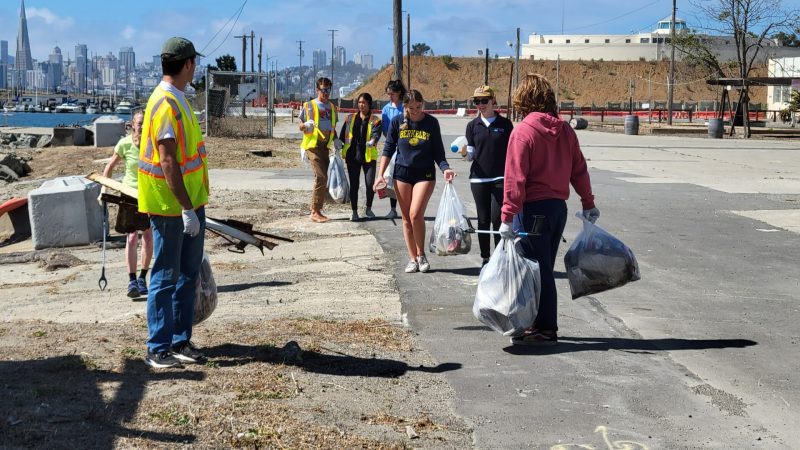
Is there anything that stood out for you in regards to the amount or kind of trash that was collected?
NC: It was too easy to pick up trash on TI. Mostly plastic and tall cans.
Was there more, or less, trash than previously?
NC: We collected less than last year.
What was the most common item collected?
NC: There were a lot of degraded plastic bags or tarps. The plastic was falling apart into pieces from weathering.
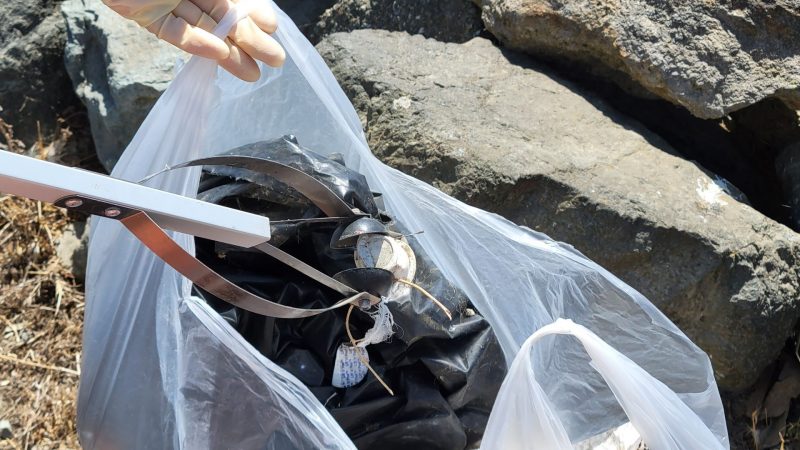
What was the most unusual item collected?
NC: Jim’s water bottle or the $5 and $1 bills! — We called Sailing Science Center president Jim Hancock to ask about how his water bottle came to be found among the trash. Jim had been walking along the shore carrying too many bags and items for his two hands, so he placed his water bottle on a piling so he could come back to get it. In the meantime, an enthusiastic trash collector had come along and picked it up as just another piece of trash. Fortunately the water bottle was located and returned to Jim. But what about the $5 and $1 bills?
“Last year we did better,” Jim said. “Last year one of the volunteers found a $10 bill.”
Apart from its being good fortune for Jim that someone found his water bottle, perhaps Treasure Island really is full of treasure!
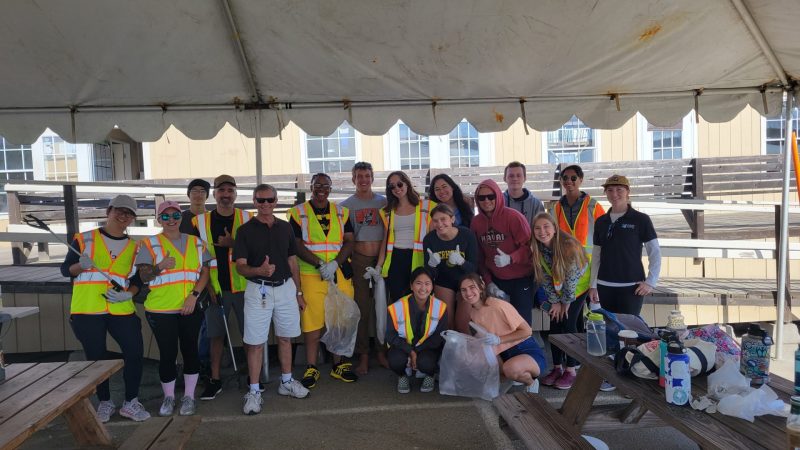
Any comments on the general state of the local environment and its future?
NC: Due to the winds the island experiences, trash can easily blow off the island into the water. Hopefully, with the increased population on Treasure Island, more will be aware of the environmental impact they have on it and keep it clean.
Thanks to San Francisco Sailing Science Center, Treasure Island Sailing Center, One Treasure Island and the Treasure Island Development Authority for organizing the day and cleaning up the island’s foreshore.
Although the next Coastal Cleanup Day won’t occur for another year, we hope we can all continue the good work done by the Treasure Island crew, and volunteers throughout California, and keep our beaches, waterways, forests and neighborhoods clear of trash.
Retiring in the Right Latitude and Attitude, Jimmy Buffett Style
It has been a while since we’ve written — with no reasonable news hook — about one James William Buffett, a man who is always sailing on warm, tropical breezes through our collective consciousness.
In May, Margaritaville at Sea Paradise set sail from Palm Beach to Grand Bahama, marking the launch of Jimmy Buffett’s Margarita at Sea cruise line. “To me, the only thing better than being on a beach by the ocean, is to be on the ocean,” Buffett was quoted as saying by Southern Living.
We’re not quite sure how many ships will fill out the line’s roster, but the line is capitalizing on a brand and lifestyle that seem to have no bounds, creating a multimillion-dollar empire that was ironically built on a folky song espousing the simple life of kicking back with some cold ones, strumming the six-string, and taking life as easy as humanly possible.
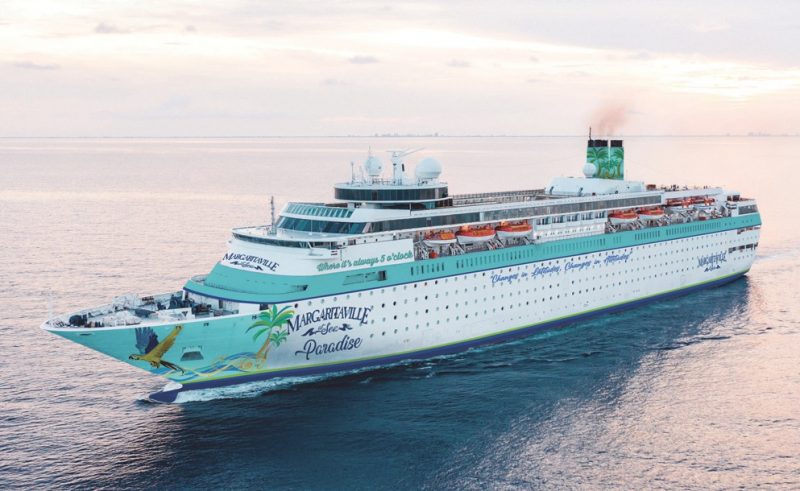
What else is included under the Margaritaville hospitality company umbrella, which sits proudly in an ice-cold cocktail of capitalism? “More than 20 million people a year pass through the doors of a Margaritaville-branded establishment,” the New Yorker wrote earlier this year. “The company, with annual system-wide sales of $1.7 billion, licenses the name to restaurants, hotels, casinos, and resorts, and sells a wide array of branded merchandise: umbrellas, towels, beach furniture, bicycles, blenders, frozen shrimp, and Key-lime-pie mix.”
And let’s not forget Latitude Margaritaville, an “active-living community for Jimmy Buffett enthusiasts, aged ’55 and better.'”
There are currently three Latitude Margaritavilles: Daytona Beach, Hilton Head, South Carolina, and Watersound, Florida, about 25 miles from Panama City — and there are likely more communities on the way. “Given the age of Buffett’s fan base, and the life style he’s hawking — as well as baby-boomer demographics — the move into active living was a natural one,” wrote New Yorker writer Nick Paumgarten. “‘Who knew people wanted to live in Margaritaville?’ Jimmy Buffett told me. ‘I thought for a while it was a myth.'”
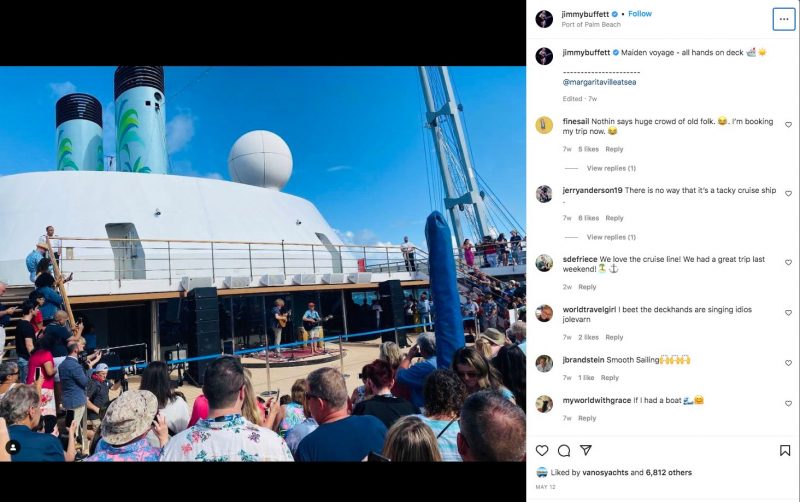
“‘It’s like being in college, but with money and without having to study,'” one Latitude Margaritaville resident told Paumgarten. “‘You have a great dorm room, you never have to go to class, and there’s always a party.” After spending several days in the Buffett-themed community, the New Yorker, known for its deep investigations and fidelity to present both sides of an issue, painted a pretty rosy, tropical-colored picture of Latitude Margaritaville.
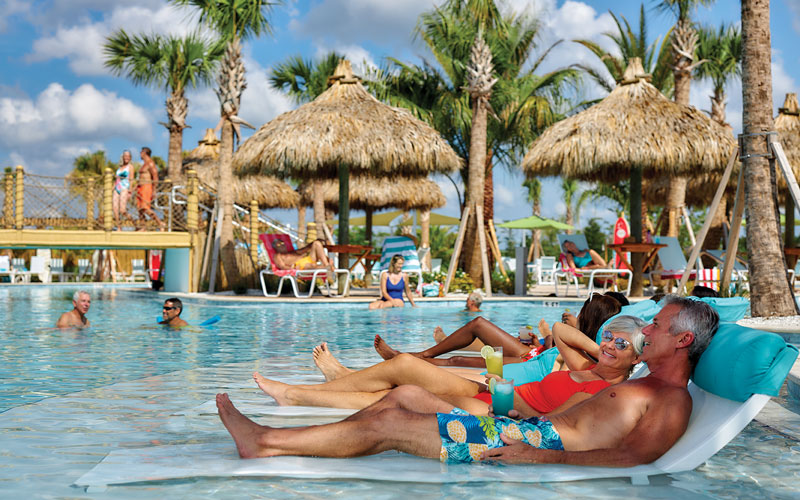
“The citizens of Latitude Margaritaville testify so consistently to a life of gratification that one suspects, but finds no evidence for, a regimen of happy pills or talking points. Disgruntlement and curmudgeonliness must exist, but not in view of a visitor susceptible to such traits.”
Looking for a lost shaker of salt never sounded so relaxing.
Has anyone considered spending their golden years in Margaritaville? Please comment below.
San Francisco on the Bay: Dock, Dine, Stay, Play
Shady Ships Signal Fake AIS Positions
See a ship on AIS? It might not be there. According to the New York Times there’s an increasing amount of fraud on the AIS system, primarily by illicit commercial shipping and fishing companies trying to avoid detection. The Times reports, “The vessels carry out the deception by adopting a technology that until recently was confined to the world’s most advanced navies. The technology, in essence, replicates the effect of a VPN cellphone app, making a ship appear to be in one place while physically being elsewhere.”
Why are ships doing this? For fishing fleets it’s pretty obvious they don’t want to be seen fishing in protected waters. If you’re a Cypriot oil tanker owner who wants to dodge sanctions on Venezuelan oil and not let your bank or insurance company find out where you are, it’s important that your AIS signal appear somewhere other than at a Venezuelan oil terminal.
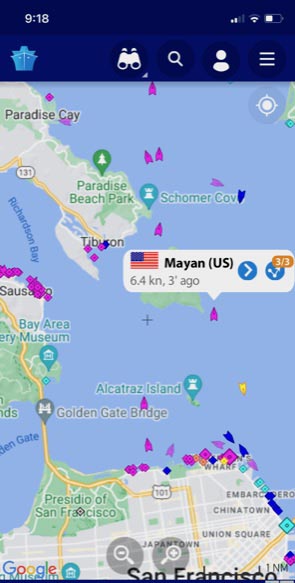
We contacted the Coast Guard asking if ships could show up in front of you on your AIS at sea, but not really be there. CWO Kurt Fredrickson of USCG Media Relations replied, “Yes, they could and could be a nuisance, but not a safety risk — vessels can’t collide with phantom targets. Note, AIS is an identification system to assist mariners in identifying targets that otherwise are seen by radar or visually. It — AIS broadcasts or AIS web services — should not be relied upon to make navigational decisions. FYI, contrary to what the NYT article insinuates, this has nothing to do with GPS. An analogy would be blaming your ISP/email service for receiving spam. Deceptive AIS reports are generated either by false AIS broadcasts or by hacking AIS web services (mostly the latter). For those relying on AIS web services, it would be difficult to ascertain what is true and what’s not.”
While it is true that you can’t hit something that’s not really there, it could be more than unsettling. Do you now mistrust your instruments? Or your eyes? AIS targets showing up on your screen through your VHF antenna are more likely to be there since it’s a local signal, but if your AIS data are coming through your Starlink or IridiumGO! internet connection, then you may be seeing things on your screen that aren’t really there. Sleep-deprived singlehanded sailors often report seeing illusions. This could only be compounded by not seeing things their instruments are telling them should be there.
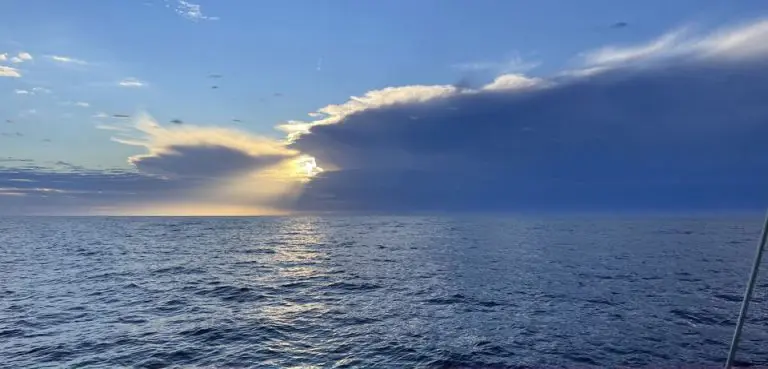
We often head to sea to escape the world’s troubles ashore. However, the technology we bring, which increasingly eases our communication and navigation challenges, comes with the risks we are trying to leave behind. AIS is getting “hacked” by illicit ships and fishing fleets, and all while the separate problem of GPS spoofing is also disrupting the perceived safety we’ve been gaining from all of this technological gadgetry. The increasing disruptions to digital navigation systems arrive at the same time that we’ve heard the major chart agencies are finally committed to phasing out paper charts.
If you are headed south with this year’s Baja Ha-Ha and bringing a sextant, you’ll be happy to know that Paul Kamen will be running a celestial navigation clinic on the beach in Turtle Bay. This will be just ahead of one of Mother Nature’s great hacks when she performs the “now you see, it now you don’t” hack by making the moon disappear during a total eclipse on November 7-8. Humans weren’t the first to fool with trusted navigational aids.
At this stage of the game, it is unlikely that the small number of devious players doing AIS hacking or GPS spoofing are going to affect the average sailor, but it’s a reminder that you should probably stick your head out of the hatch frequently at sea and change your passwords frequently while ashore. Sailing teaches eternal vigilance, and a “belt-and-suspenders” approach to navigation will remain a wise practice for the foreseeable future.
Galápagos National Park — A Dream Dive Destination
In 2008, Dustin Reynolds almost lost his life after the motorcycle he was riding was hit by a drunk driver. Sailing became a large part of his recovery, and in the years since, he became the first double amputee to sail around the world singlehanded, a record he set with a 7.5-year circumnavigation from Hawaii. This month we shared another part of Dustin’s sailing story in the September issue of Latitude 38.
The Galápagos have been a dream of mine as a dive destination for most of my life. Since first seeing videos of schooling hammerheads, whale sharks, and penguins, it was destination No. 1 on my bucket list and the place that first put the idea of world cruising in my mind.
Sailing to the Galápagos is tricky and very expensive, which is why a majority of boats bound for Polynesia sail right by them. An agent is required to file your permits at least two months in advance. My permit and agent fees for two months and the four inhabited islands were $2,500. I was fortunate to be awarded the Ocean Cruising Club Challenge Grant, which is the only way I was able to afford it.
My trip from Panama to the Galápagos was a tough one. It was past the good season to make the trip, and the ITCZ was way north, bringing SW winds for me the whole way. Nine days pointing as high as I could into 15-30 knots of surprisingly cold winds for being near the equator. I even tacked the first five days south before turning west 80 miles north of Ecuador. It had been a long time since I purposely bashed into the wind and waves on a passage. This rough trip revealed some new leaks to fix and how tender of a sailor I had become after two years of cruising the Atlantic.
Arriving in the Galápagos is a special thing. During my last two days at sea, I had several red-footed boobies painting my deck and solar panels white and green. Sailing north of San Cristóbal Island and down the leeward side reminded me so much of Hawaii: volcanic mountains rising from the ocean, fishing and tour boats zipping around, and dolphins swimming in Tiama‘s wake. After dropping anchor, I went for a quick swim to check the anchor and rinse off nine days of salt and sweat.
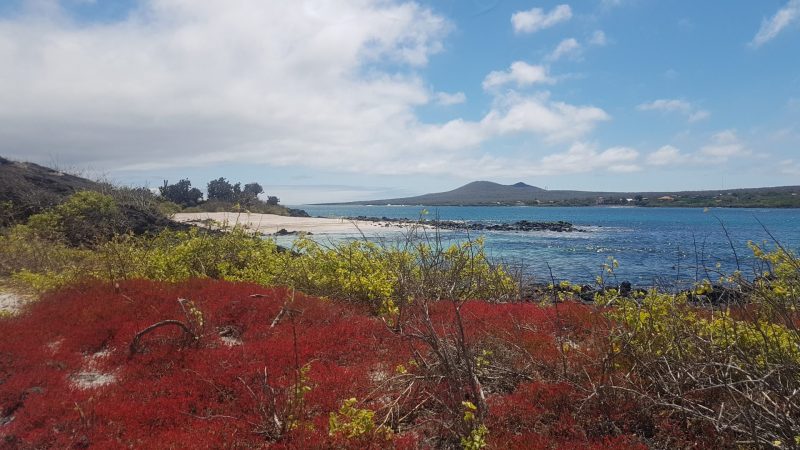
My check-in process was fairly easy. All the officials and my agent Gian came to the boat along with a doctor to do a health/COVID test. A diver also swung by to check the bottom for growth. My boat was fine, but I do have a friend who had to sail 40 miles out to clean the bottom and come back in.
San Cristóbal was an amazing first stop. As soon as you take the water taxi to shore there are lounging sea lions, pelicans, and marine iguanas on the dock. San Cristóbal sea lions are like town drunks — barking, moaning, and growling incoherently. I saw them passed out on beaches, sidewalks, benches, and even atop a lighthouse. The waterfront is lined with restaurants and tourist shops, which were open but mostly empty during COVID times.
I did two self-guided hikes on San Cristóbal — one south of the airport along Playa Loberia and up the hill to Acantilado La Loberia, and the other north of town that offered incredible hilltop views in the company of a statue of Darwin. Down the stairs from the statue, I discovered my favorite Galápagos swimming hole in a protected bay on the leeward side of the island that was full of playful sea lions, indifferent turtles, and lounging iguanas.
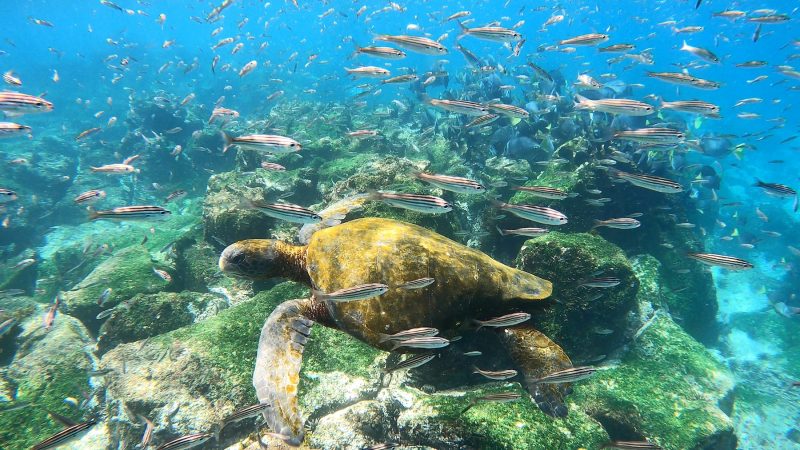
Continue reading Dustin’s story at Latitude38.com.
Westwind Yacht Management — Washing, Waxing and Varnishing
Westwind Yacht Management: Premiere Yacht & Fleet services for the San Francisco Bay Area.


